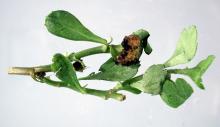Cause The bacterium Agrobacterium tumefaciens enters plants through wounds, either natural or caused by pruning, grafting, mechanical injury, chewing insects, or the emergence of lateral roots. Pruning or cutting tools that cut through galls can become contaminated with the bacteria and spread them to cut surfaces of subsequently pruned plants. Galls can also occur at sites of lateral shoot removal or pinching of terminals. The bacteria can be systemic in plants. After the bacterium enters a wound, a small piece of its DNA is transferred into the plant's DNA. The foreign DNA transforms normal plant cells in the wounded area into tumor cells. Once transformed, tumor cells proliferate automatically. The result is a gall: a disorganized mass of hyperplastic and hypertrophic tissue. Galls break down in the soil and release bacteria, which can be transported by moving media or water. These bacteria are viable in galled tissue and infected plants for 6 to 8 weeks. Galls on roots or stems disrupt the normal flow of water and nutrients and can lead to reduced growth. Many plants in 90 families are susceptible but woody perennials such as stone and pome fruit, caneberries (such as blackberry and raspberry), euonymus, Photinia, poplar, rose, walnut, and willow are typically infected.
Symptoms Galls are often at or just below the soil surface in the basal or root crown region and can reach 1.5 to 2 inches in size. They may frequently be on roots, less frequently on aerial plant parts such as stems and leaves. Galls are usually rounded with a rough, irregular surface. They first appear as small protuberances on the plant surface. Young, actively developing galls are light green or nearly white, and the tissue is soft. As they age, galls become dark and woody. Sometimes galls have a rather smooth surface, which makes it difficult to distinguish between gall and callus growth, especially if the gall is at the base of an unrooted cutting.
Galls can occur on leaves on lateral or mid-veins and appear smooth, light tan-colored usually less than 0.25 inch in size. Galls can occur on both sides of the leaf.
Cultural control
- Use only pathogen-free nursery stock. Inspect new plants; do not plant any that have galls.
- Use soilless potting mix or steam-treated soil and rooting media. Steam 30 min. at 180°F. Also disinfect any tools and equipment that might be used and contaminate the media.
- Avoid wounding plants, especially at planting.
- Disinfect cutting equipment frequently. Clean shears and long soak times improve the disinfectant's efficacy.
- Scout for and destroy affected plants including potting media and pots.
- Resistance has been reported for the cultivars Epidote Jaune, Epidote Orange, and Epidote Rouge.
Reference Miller, H.N. 1975. Leaf, stem, crown, and root galls induced in chrysanthemum by Agrobacterium tumefaciens. Phytopathology 65:805-811.



